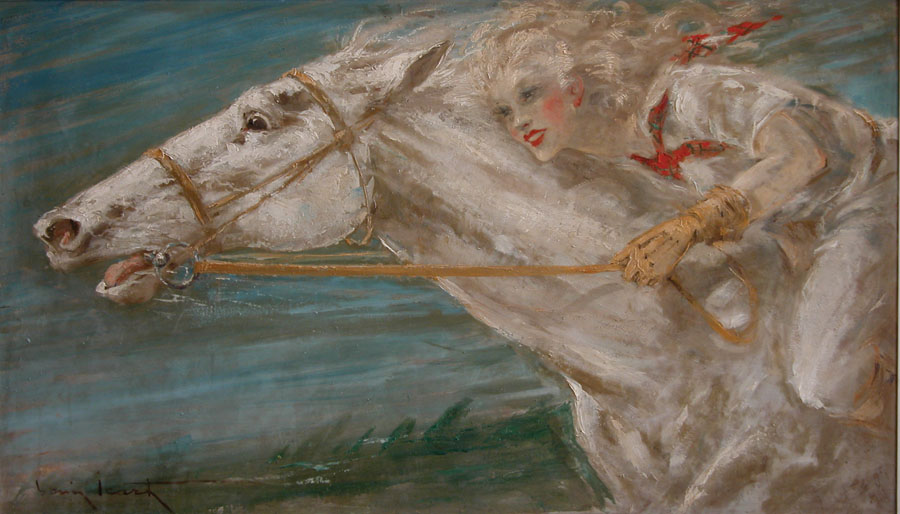Louis Justin Laurent
Icart
1888-1950
Louis Icart was born in 1888 in Toulouse, France. He began drawing at
an early age. His move to Paris is believed to involve his aunt, she
owned a fashionable millinery shop called Maison Valmont. While visiting
the Icart family saw young Louis’ work, was very impressed, and
brought him to the Paris.
Icart started his career in a studio that produced sexy postcards of
the type the French were famous. His first job was to make copies of
existing images, but he soon began designing original works. He successfully
submitted his original works to magazines and was commissioned to design
covers for La Critique Théâtrale.
Icart enjoyed rapid acceptance as an illustrator of catalogues for fashion
houses, and in 1913 he was invited to exhibit at the Salon des Humoristes.
The tradition of fine art etchings of beautiful women became popular
in France with artists like Paul-César Helleu and Manuel Robbe.
Icart learned the technique of etching on copper and took the art to
new heights. Combing his understanding of fashion, his obvious love
of beautiful women, and understanding the commercial value of his work
Icart became one of the most popular artists of his time.
Icart met his second wife Fanny in 1914; she became his most popular
model. She was an artist in her own right and a ravishing blonde beauty.
He was drafted into the military in World War One; he became a pilot
and flew combat missions. He sketched constantly during the war and
did many etchings with patriotic themes.
Icart is known worldwide for his etchings, it is believed he created
more than 500 etchings in his lifetime. He also illustrated more than
thirty books, many extremely erotic, and became an accomplished painter
as well. He had several distinctive styles over the years, which are
mostly expressed in his color palette. Many of his early paintings are
moody, with use of browns, gold, and reds. As the times became brighter
so did his paintings. In 1920 he exhibited at Galerie Simonson in Paris,
and received mixed critical revues. Icart’s work was influenced
by the Impressionists, like many other painters he took what he needed
from them and used it in communicating his own vision of his times.
His paintings are very personal and less commercial than his etchings;
they were created for his own pleasure and not specifically intended
to reach a large public audience. He exhibited frequently in Parisian
galleries and several times in New York.
In 1922 Louis and Fanny Icart traveled to New York City for his first
American exhibition. The exhibition was at Belmaison a gallery at John
Wanamaker’s department store, and the exhibit later moved to Wanakamers
in Philadelphia. He exhibited fifty oil paintings, and was met with
mixed reviews.
In 1932 the Louis Icart Society, an organization created to market his
etchings, exhibited a collection of paintings called “Les Visions
Blanches.” They were shown at the Metropolitan Galleries in New
York, many of the canvases were subjects similar to his popular etchings.
Because Icart himself did not attend the exhibition it did not attract
much publicity.
After the German invasion in 1940, Icart turned to a more serious subject.
Her executed a series of paintings documenting the horrors of the occupation.
This collection was called L’Exode, Icart like many of his countrymen
fled Paris; these works chronicle that exodus. In the 1970s, when a
renewed interest in Icart’s work was taking hold, a group of these
paintings, along with several large earlier works were discovered in
an attic storage facility of a Paris art academy, a sort of graveyard
of forgotten art.
Icart captured the romance of Les Années Folles. His unabashed
eroticism, and his incredible prolific nature gained him world renown
and made him quite wealthy. From 1930 he lived in a magnificent house
in Montmartre with a breathtaking view of Paris.
With the resurgence of interest in the Art Deco period, Icart’s
works have enjoyed an unprecedented revival. There are several books
in print on the artist. Louis Icart is one of the most recognized artists
specifically identified with Art Deco, he is included in this collection
in order to draw attention to his paintings, any collection of works
of this period would be lacking without Icart’s inclusion.
|
